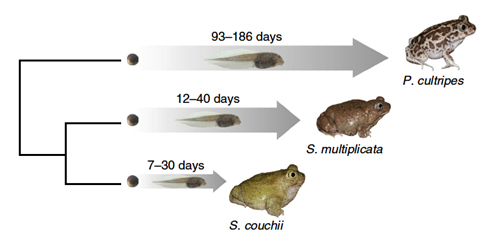Phenotypic differences among species may evolve through genetic accommodation, but mechanisms accounting for this process are poorly understood. Here hormonal variation underlying differences in the timing of metamorphosis among three spadefoot toads with different larval periods and responsiveness to pond drying is compared. Results show that, in response to pond drying, Pelobates cultripes and Spea multiplicata accelerate metamorphosis, increase standard metabolic rate (SMR), and elevate whole-body content of thyroid hormone (the primary morphogen controlling metamorphosis) and corticosterone (a stress hormone acting synergistically with thyroid hormone to accelerate metamorphosis). In contrast, Scaphiopus couchii has the shortest larval period, highest whole-body thyroid hormone and corticosterone content, and highest SMR, and these trait values are least affected by pond drying among the three species. These findings support that the atypically rapid and canalized development of S. couchii evolved by genetic accommodation of endocrine pathways controlling metamorphosis, showing how phenotypic plasticity within species may evolve into trait variation among species. informacion[at]ebd.csic.es: Kulkarni et al (2017) Genetic accommodation via modified endocrine signalling explains phenotypic divergence among spadefoot toad species. Nat Commun doi:10.1038/s41467-017-00996-5
https://www.nature.com/articles/s41467-017-00996-5

 Las altas temperaturas están provocando que las lagunas y las marismas de Doñana pierdan agua rápidamente
Las altas temperaturas están provocando que las lagunas y las marismas de Doñana pierdan agua rápidamente




